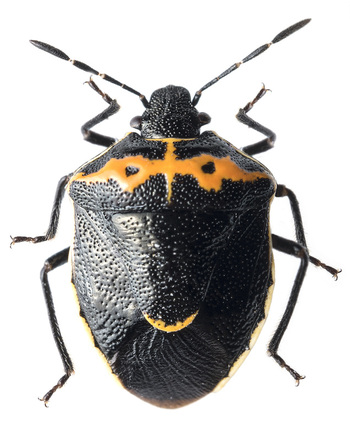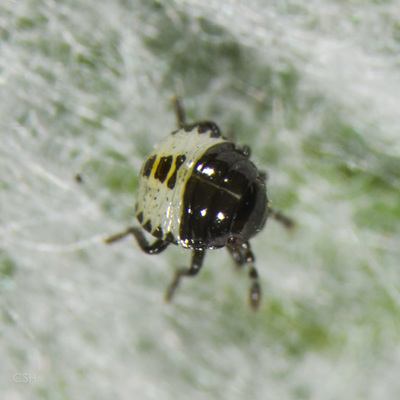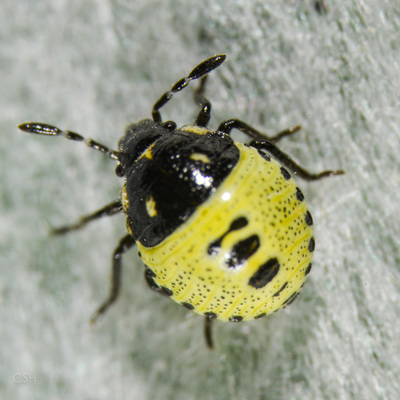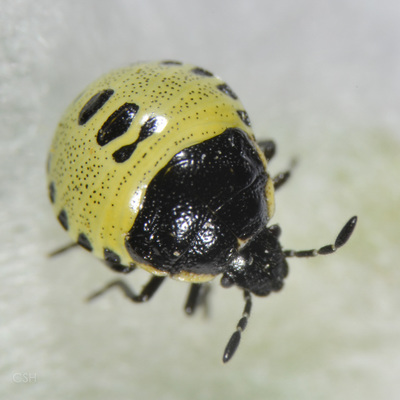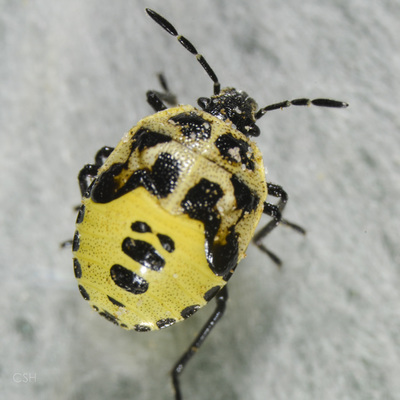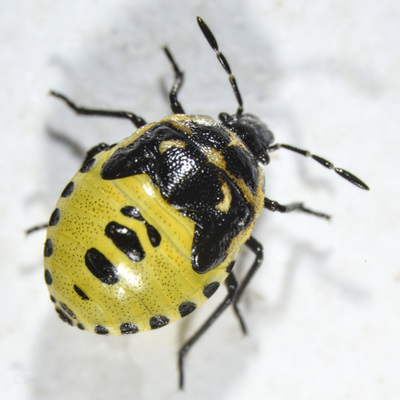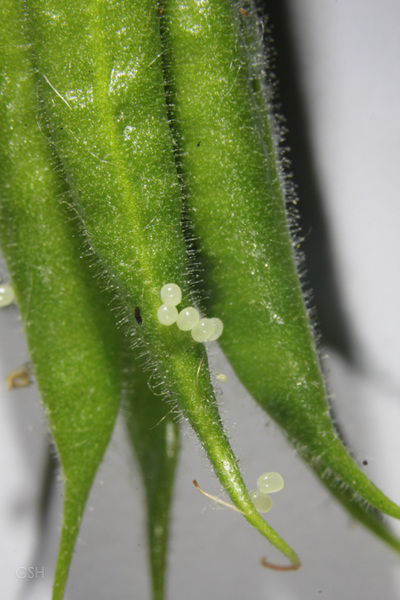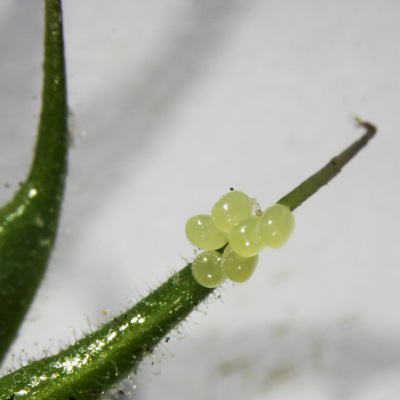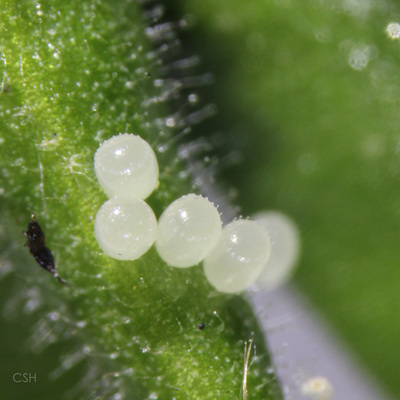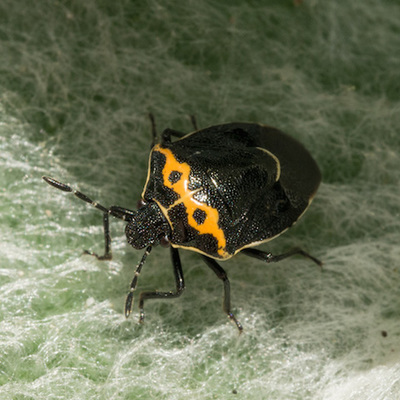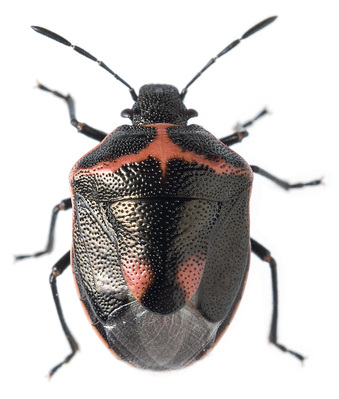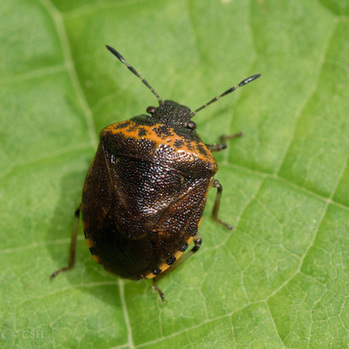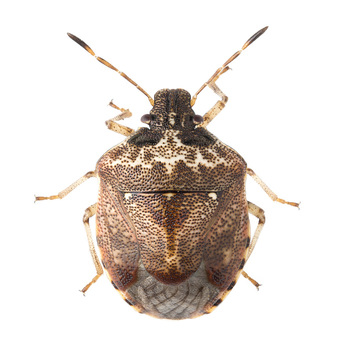There are four species of Cosmopepla known from Oregon.
Cosmopepla conspicillaris - hedge-nettle stink bug
Size: 5 - 7mm
Description: Glossy black dorsally with margins of scutellum and hemelytra outlined in yellow or orange. Pronotum with markings that resemble spectacles, with a lateral yellow or orange line in the middle of the pronotum. Tip of scutellum edged in white. Wing membranes. Legs and antennae black or very dark brown.
Hosts: In literature,
C. conspicillaris is commonly found on Stachys palustris, commonly called hedge-nettle or woundwart. Also found on Stachys bizantia (Lamb’s ear) in Corvallis. Collected in Corvallis, Oregon on pathfinder (Adenocaulon bicolor) and columbine (Aquilegia spp.).
Range: Western United States. In Oregon, specimens collected primarily in western region of the state.
Below are nymphs of Cosmopepla conspicillaris, but other Cosmopepla nymphs have similar looking patterns.
Description: Glossy black dorsally with margins of scutellum and hemelytra outlined in yellow or orange. Pronotum with markings that resemble spectacles, with a lateral yellow or orange line in the middle of the pronotum. Tip of scutellum edged in white. Wing membranes. Legs and antennae black or very dark brown.
Hosts: In literature,
C. conspicillaris is commonly found on Stachys palustris, commonly called hedge-nettle or woundwart. Also found on Stachys bizantia (Lamb’s ear) in Corvallis. Collected in Corvallis, Oregon on pathfinder (Adenocaulon bicolor) and columbine (Aquilegia spp.).
Range: Western United States. In Oregon, specimens collected primarily in western region of the state.
Below are nymphs of Cosmopepla conspicillaris, but other Cosmopepla nymphs have similar looking patterns.
Cosmopepla lintneriana - twice-stabbed stink bug
Size: 4 - 5mm
Description: Frequently referred to as Cosmopepla bimaculata. Small black body with red cross marking on pronotum. Scutellum with two red markings on either side (these markings are where it gets its latin synonym and common name, two (bi-) stab marks (-maculata).
Hosts: In Oregon, observed on lamb’s ear, geranium, seed heads of wild carrot, columbine, thimbleberry, and many other plants.
Range: Common throughout Oregon and the United States.
Description: Frequently referred to as Cosmopepla bimaculata. Small black body with red cross marking on pronotum. Scutellum with two red markings on either side (these markings are where it gets its latin synonym and common name, two (bi-) stab marks (-maculata).
Hosts: In Oregon, observed on lamb’s ear, geranium, seed heads of wild carrot, columbine, thimbleberry, and many other plants.
Range: Common throughout Oregon and the United States.
Cosmopepla uhleri
Size: 4 - 5mm
Description: Reddish brown with a distinctive irregular orange (or yellow or red) band across the pronotum. Pronotum without pale edges seen in other Cosmopepla species. Antennae dark brown. Edge of abdomen with alternating light and dark bands. Underside black.
Hosts: Collected on columbine (Aquilegia sp.). Also collected on thimbleberry in Portland (Rubus parviflorus) and wild Geranium spp.
Range: Specimens in Oregon collected in and around Portland, but extent of range in the state is unknown. In the U.S., known range is western United States to Nebraska.
Description: Reddish brown with a distinctive irregular orange (or yellow or red) band across the pronotum. Pronotum without pale edges seen in other Cosmopepla species. Antennae dark brown. Edge of abdomen with alternating light and dark bands. Underside black.
Hosts: Collected on columbine (Aquilegia sp.). Also collected on thimbleberry in Portland (Rubus parviflorus) and wild Geranium spp.
Range: Specimens in Oregon collected in and around Portland, but extent of range in the state is unknown. In the U.S., known range is western United States to Nebraska.
Cosmopepla intergressa
Size: 4 - 5mm
Description: Very round with brown speckled appearance. Often appears slightly metallic or coppery, especially on the ventral side. Wing membranes often with dark venation. Pronotum with light colored band. Scutellum with three ivory colored spots. Antennae light except for last segment.
Hosts: Common on thimbleberry, raspberry, and other Rubus spp. and Geranium spp. Collected from wild currant (Ribes spp.) in southern Oregon.
Range: Found throughout Oregon. Common in the Willamette Valley. Found in the western United States to Kansas and Missouri.
Description: Very round with brown speckled appearance. Often appears slightly metallic or coppery, especially on the ventral side. Wing membranes often with dark venation. Pronotum with light colored band. Scutellum with three ivory colored spots. Antennae light except for last segment.
Hosts: Common on thimbleberry, raspberry, and other Rubus spp. and Geranium spp. Collected from wild currant (Ribes spp.) in southern Oregon.
Range: Found throughout Oregon. Common in the Willamette Valley. Found in the western United States to Kansas and Missouri.
